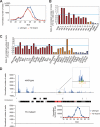The Yb body, a major site for Piwi-associated RNA biogenesis and a gateway for Piwi expression and transport to the nucleus in somatic cells
- PMID: 21106531
- PMCID: PMC3030380
- DOI: 10.1074/jbc.M110.193888
The Yb body, a major site for Piwi-associated RNA biogenesis and a gateway for Piwi expression and transport to the nucleus in somatic cells
Abstract
Despite exciting progress in understanding the Piwi-interacting RNA (piRNA) pathway in the germ line, less is known about this pathway in somatic cells. We showed previously that Piwi, a key component of the piRNA pathway in Drosophila, is regulated in somatic cells by Yb, a novel protein containing an RNA helicase-like motif and a Tudor-like domain. Yb is specifically expressed in gonadal somatic cells and regulates piwi in somatic niche cells to control germ line and somatic stem cell self-renewal. However, the molecular basis of the regulation remains elusive. Here, we report that Yb recruits Armitage (Armi), a putative RNA helicase involved in the piRNA pathway, to the Yb body, a cytoplasmic sphere to which Yb is exclusively localized. Moreover, co-immunoprecipitation experiments show that Yb forms a complex with Armi. In Yb mutants, Armi is dispersed throughout the cytoplasm, and Piwi fails to enter the nucleus and is rarely detectable in the cytoplasm. Furthermore, somatic piRNAs are drastically diminished, and soma-expressing transposons are desilenced. These observations indicate a crucial role of Yb and the Yb body in piRNA biogenesis, possibly by regulating the activity of Armi that controls the entry of Piwi into the nucleus for its function. Finally, we discovered putative endo-siRNAs in the flamenco locus and the Yb dependence of their expression. These observations further implicate a role for Yb in transposon silencing via both the piRNA and endo-siRNA pathways.
Figures






Similar articles
-
Roles for the Yb body components Armitage and Yb in primary piRNA biogenesis in Drosophila.Genes Dev. 2010 Nov 15;24(22):2493-8. doi: 10.1101/gad.1989510. Epub 2010 Oct 21. Genes Dev. 2010. PMID: 20966047 Free PMC article.
-
An in vivo RNAi assay identifies major genetic and cellular requirements for primary piRNA biogenesis in Drosophila.EMBO J. 2010 Oct 6;29(19):3301-17. doi: 10.1038/emboj.2010.212. Epub 2010 Sep 3. EMBO J. 2010. PMID: 20818334 Free PMC article.
-
Yb integrates piRNA intermediates and processing factors into perinuclear bodies to enhance piRISC assembly.Cell Rep. 2014 Jul 10;8(1):103-13. doi: 10.1016/j.celrep.2014.05.043. Epub 2014 Jun 19. Cell Rep. 2014. PMID: 24953657
-
The piRNA pathway in Drosophila ovarian germ and somatic cells.Proc Jpn Acad Ser B Phys Biol Sci. 2020;96(1):32-42. doi: 10.2183/pjab.96.003. Proc Jpn Acad Ser B Phys Biol Sci. 2020. PMID: 31932527 Free PMC article. Review.
-
A novel epigenetic mechanism in Drosophila somatic cells mediated by Piwi and piRNAs.Cold Spring Harb Symp Quant Biol. 2008;73:273-81. doi: 10.1101/sqb.2008.73.056. Epub 2009 Mar 6. Cold Spring Harb Symp Quant Biol. 2008. PMID: 19270080 Free PMC article. Review.
Cited by
-
The comprehensive epigenome map of piRNA clusters.Nucleic Acids Res. 2013 Feb 1;41(3):1581-90. doi: 10.1093/nar/gks1275. Epub 2012 Dec 20. Nucleic Acids Res. 2013. PMID: 23258708 Free PMC article.
-
Biogenesis and mechanism of action of small non-coding RNAs: insights from the point of view of structural biology.Int J Mol Sci. 2012;13(8):10268-10295. doi: 10.3390/ijms130810268. Epub 2012 Aug 17. Int J Mol Sci. 2012. PMID: 22949860 Free PMC article. Review.
-
Defining the expression of piRNA and transposable elements in Drosophila ovarian germline stem cells and somatic support cells.Life Sci Alliance. 2019 Oct 16;2(5):e201800211. doi: 10.26508/lsa.201800211. Print 2019 Oct. Life Sci Alliance. 2019. PMID: 31619466 Free PMC article.
-
"Dot COM", a nuclear transit center for the primary piRNA pathway in Drosophila.PLoS One. 2013 Sep 9;8(9):e72752. doi: 10.1371/journal.pone.0072752. eCollection 2013. PLoS One. 2013. PMID: 24039799 Free PMC article.
-
Tdrd1 acts as a molecular scaffold for Piwi proteins and piRNA targets in zebrafish.EMBO J. 2011 Jul 8;30(16):3298-308. doi: 10.1038/emboj.2011.228. EMBO J. 2011. PMID: 21743441 Free PMC article.
References
Publication types
MeSH terms
Substances
Associated data
- Actions
Grants and funding
LinkOut - more resources
Full Text Sources
Other Literature Sources
Molecular Biology Databases

